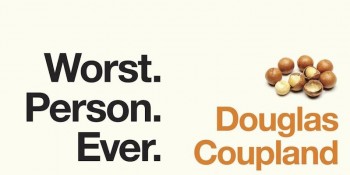Close your eyes and think of the worst person you know. I’m not talking serial-killer-sociopathic bad, just someone you actually know and would consider the worst person ever. I’m sure everyone has at least one person. Can you picture them? Whomever you thought of just now probably doesn’t even begin to come close to Raymond Gunt, the lead character of Douglas Coupland‘s latest novel, aptly titled Worst. Person. Ever.
Gunt is a cameraman hired by his ex-wife to work on a Survivor-like television show being filmed on the small island nation of Kiribati. Thus begins his odyssey from London to Kiribati, with many obstacles along the way, including layovers in the United States and a detour to nuke the Pacific Trash Vortex. Gunt’s traveling companion, Neal, is a homeless man he hired to be his personal assistant, or “slave,” while he is on the island.
Gunt is exactly as the title suggests and has absolutely no redeeming qualities. He’s selfish, rude, racist, sexist, jokes about bestiality and atrocity, and swears more than the characters in a Martin Scorcese film. He has little to no conscience and, despite living in a small, cramped apartment and working as a low-level cameraman, acts like he’s a gift to the universe. Even more, he has no idea how bad he really is — everybody else is the problem.
With Gunt narrating the book, the reader is given a first-hand account of his actions and his motivations, which just serves to make him appear even worse. But Gunt isn’t the only problem. Every character in this novel is rather despicable in their own way. Of course, this is assuming Gunt is a reliable narrator. Of the main characters in the novel, Neal is probably the only one who is remotely likable; his laid-back, hippie-esque attitude also creates the most amusement throughout their adventures.
Coupland’s novels are frequently innovative in style and visual presentation. In Worst. Person. Ever., Coupland uses informational boxes at the end of each chapter, and they degenerate from factual in the early chapters to subjective opinions near the end. These sidebars do contain interesting facts; I admit I did not know about the Pacific Trash Vortex until reading this novel, and even after seeing the sidebar, I had to research the topic on my own before I believed it.
It’s difficult to say what Coupland’s goal is in writing this novel. It appears to be a commentary on the excess of human consumption, with possible criticism of Americans thrown in. Coupland himself is Canadian, and the satire is so heavy at times that the reader is left to question whether it crosses the line into actual bad feelings.
Is this truly social commentary, or is it just a novel about a truly terrible person? Given Coupland’s previous works, it’s hard to say, but I lean toward this being an extremely biting commentary, the actual intent of which may be completely lost in the absurdity of the plot and the lack of any redeeming characters to root for.
Coupland has written some great novels, but with Worst. Person. Ever., I feel he misses the mark. It’s hard to look past the harshness and obscenity of his narrator. There were some amusing moments — and I may have even laughed out loud more than once — but I’m not sure the humor made up for the vileness of the characters. The book is a quick read, so even if by the end you haven’t enjoyed it, you haven’t wasted too much time of your time.
I haven’t read Coupland’s more famous Generation X: Tales for an Accelerated Culture, but I found The Gum Thief: A Novel
much more enjoyable. If you’re a fan of Coupland and other writers of darker literature, such as Chuck Palahniuk and Bret Easton Ellis, you may enjoy this novel, especially if you don’t mind the lack of any likable characters. However, if you’ve never read Coupland or those of his ilk, I wouldn’t recommend starting with this novel.
Worst. Person. Ever. isn’t the worst book I’ve read, but it’s far from the best.
